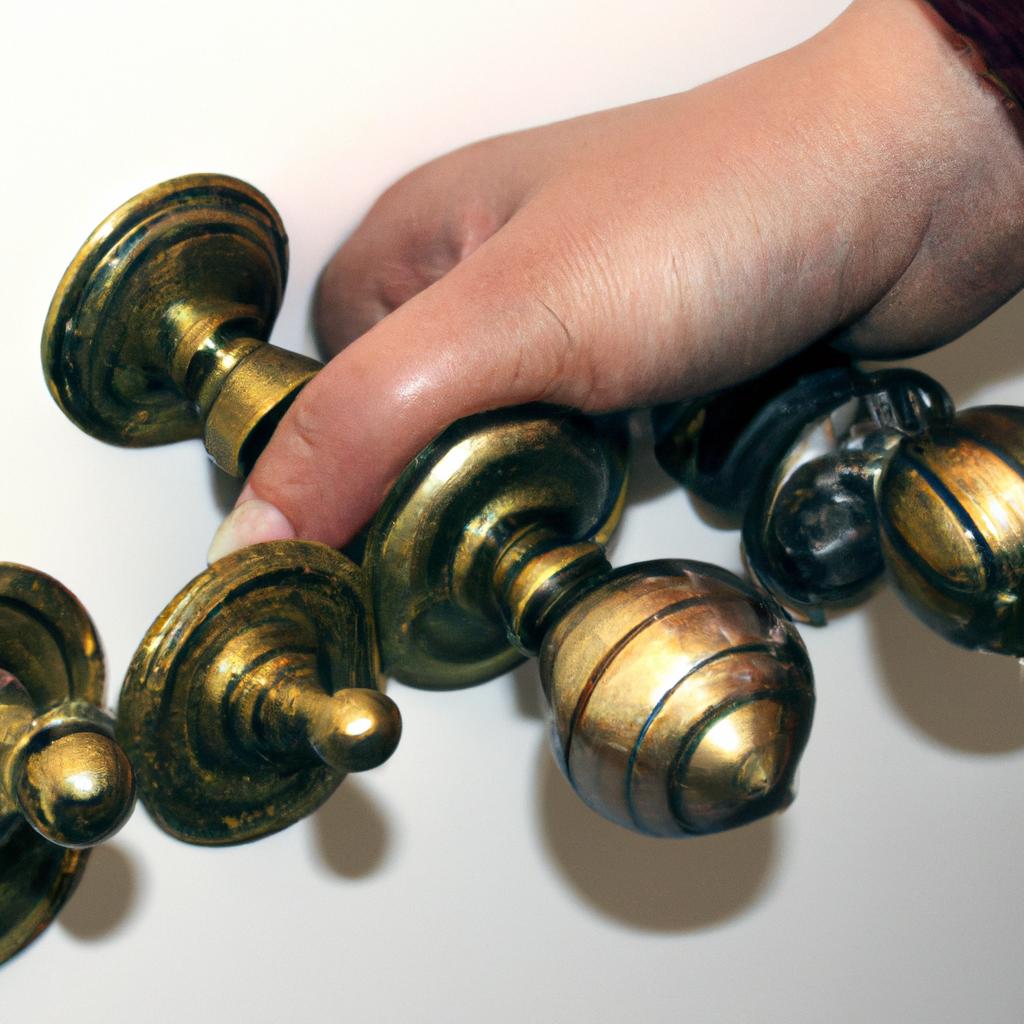The proper functioning of door closers is crucial in the lumber and building materials industry. These devices play a significant role in maintaining the safety, security, and efficiency of various structures. For instance, consider a hypothetical scenario where a large warehouse stores valuable construction supplies. Without an effective door closer system, there would be a risk of unauthorized access or damage caused by open doors. Thus, understanding the different types of door closers available in this industry and their specific applications becomes essential for professionals working with lumber and building materials.
This informative guide aims to provide comprehensive information about door closers in the context of the lumber and building materials sector. By exploring various aspects such as types, installation methods, maintenance requirements, and common issues faced with these devices, readers will acquire valuable knowledge necessary for decision-making processes related to door closure systems. Whether it is selecting an appropriate type of door closer for a particular application or troubleshooting problems that may arise over time, this article acts as a reliable resource for individuals involved in managing or utilizing lumber and building material facilities.
Types of door closers
Types of Door Closers
Imagine a scenario where a commercial building is located in an area prone to strong winds and heavy foot traffic. The doors constantly slam shut, causing inconvenience and potential safety hazards for users. To address this issue, door closers come into play as crucial components of the overall door system. In this section, we will discuss the different types of door closers commonly used in lumber and building materials.
Firstly, let us explore hydraulic door closers. These are widely utilized due to their reliable performance and versatility. Hydraulic door closers use fluid pressure to control the speed at which the door closes, ensuring smooth operation without abrupt slamming or jerking motions. This type of closer offers adjustable closing speeds, making it suitable for various applications such as office buildings, hospitals, and schools.
Secondly, we have pneumatic door closers that operate based on air pressure. Similar to hydraulic closers, they provide controlled closing action but rely on compressed air instead of fluids. Pneumatic door closers are popular choices for lightweight doors in residential settings or low-traffic areas where cost-effectiveness is desired.
Thirdly, electromagnetic door closers offer unique advantages in terms of convenience and accessibility. By utilizing magnetic force when activated by an electric current, these closers ensure automatic closure upon sensing movement within proximity. Such technology finds extensive application in places like shopping malls or hospitals where hands-free access is essential.
Lastly, concealed overhead door closers stand out with their discreet appearance while maintaining functionality. As suggested by their name, these types of closers are installed inside the frame or top rail of the door itself, rendering them nearly invisible from both sides when the door is closed. Concealed overhead door closers blend seamlessly with architectural aesthetics and deliver reliable closing actions even under challenging conditions.
- Hydraulic door closers: Ensures controlled closing without abrupt slamming
- Pneumatic door closers: Cost-effective option for lightweight doors in residential settings
- Electromagnetic door closers: Enables hands-free access and automatic closure
- Concealed overhead door closers: Discreet appearance while providing reliable function
Additionally, we can visualize the comparison between these types of door closers using the following table:
| Types of Door Closers | Advantages |
|---|---|
| Hydraulic | – Adjustable closing speed |
| – Smooth operation | |
| Pneumatic | – Cost-effective |
| – Suitable for lightweight doors | |
| Electromagnetic | – Hands-free access |
| – Automatic closure upon sensing movement | |
| Concealed Overhead | – Discreet appearance |
| – Reliable function even under challenging conditions |
In summary, understanding the various types of door closers available is crucial when considering their application in lumber and building materials. By selecting the appropriate type based on specific requirements, one can ensure optimal functionality, convenience, and safety within a given space.
Moving forward to the next section on “Benefits of using door closers in lumber and building materials,” we will explore how these devices contribute to enhanced security and energy efficiency in commercial buildings.
Benefits of using door closers in lumber and building materials
Transitioning from the previous section on different types of door closers, we now delve deeper into their functionality and benefits in lumber and building materials. To illustrate this further, let us consider a hypothetical scenario where a large hardware store recently installed door closers across its premises.
Upon installation, the management noticed several positive outcomes that strengthened their decision to incorporate door closers into their establishment:
- Enhanced Security: The presence of door closers improved security by ensuring that doors automatically closed behind individuals, reducing the risk of unauthorized access or potential breaches.
- Energy Efficiency: With door closers in place, the store experienced reduced heat loss during colder months and minimized air conditioning escape during warmer seasons. This led to substantial energy savings over time.
- Noise Reduction: The utilization of door closers significantly diminished noise pollution within the store environment. Customers appreciated the quieter atmosphere while browsing through products, leading to increased customer satisfaction levels.
- Improved Accessibility and Safety: By providing controlled closing mechanisms on doors, including those equipped with accessibility features such as automatic opening capabilities, door closers facilitated ease of entry for customers with diverse mobility needs.
These advantages can be better understood through a visual representation:
| Advantages | Description |
|---|---|
| Enhanced Security | Automatic closure reduces unauthorized access risks |
| Energy Efficiency | Minimizes heat/cooling loss for cost-effective temperature control |
| Noise Reduction | Creates quieter ambiance for enhanced shopping experience |
| Improved Accessibility and Safety | Facilitates convenient entry for all customers |
In conclusion, door closers offer numerous benefits when incorporated into lumber and building material establishments like our hypothetical hardware store case study. These advantages include heightened security measures, energy efficiency improvements, noise reduction capabilities, and enhanced accessibility/safety features.
Moving forward into the subsequent section about factors to consider when choosing a door closer, it is crucial to evaluate specific criteria to ensure optimal selection and installation. By examining various factors, businesses can make informed decisions that align with their unique requirements and objectives.
Factors to consider when choosing a door closer
Case Study:
Consider a scenario where a construction company is in the process of renovating an old building. The project involves replacing the doors throughout the structure with new ones suitable for commercial use. In order to ensure safety, security, and convenience, the company must carefully select door closers that meet their specific needs.
Factors to Consider:
-
Size and Weight Capacity: One crucial factor to consider when choosing a door closer for lumber and building materials is its size and weight capacity. It is essential to determine the compatible dimensions and weight limits of the chosen door closer in relation to the type of doors being installed. For example, if heavy-duty doors made from solid wood are being used, it is imperative to select a door closer capable of handling their weight effectively.
-
Functionality: Different spaces within a building may require different functionality from door closers. Some areas might benefit from adjustable closing speed or hold-open features, while others may need delayed action capabilities for accessibility purposes. Assessing these functional requirements before making a decision will help ensure that the selected door closers meet specific needs appropriately.
-
Durability and Maintenance: Another important consideration is the durability and maintenance required for door closers in lumber and building materials applications. Investing in high-quality products that can withstand constant usage, exposure to harsh weather conditions, or potential vandalism will reduce long-term costs associated with replacements or repairs. Additionally, selecting models that offer ease of maintenance will simplify upkeep tasks over time.
-
Aesthetics: While primarily functional, door closers should also be visually appealing as they contribute to the overall appearance of buildings. Opting for designs that blend seamlessly with architectural styles enhances both interior and exterior aesthetics.
- Ensures secure closure of doors, minimizing unauthorized access
- Enhances safety by preventing slamming incidents
- Provides convenient hands-free operation
- Reduces energy costs by maintaining proper insulation
Emotional table:
| Factors to Consider | Benefits |
|---|---|
| Size and Weight Capacity | Ensures smooth closure of heavy doors |
| Functionality | Enhances accessibility and convenience |
| Durability and Maintenance | Minimizes long-term replacement or repair costs |
| Aesthetics | Contributes to the overall visual appeal |
In light of these factors, selecting the most suitable door closers for lumber and building materials applications is crucial. By carefully considering size and weight capacity, functionality, durability and maintenance requirements, as well as aesthetics, construction companies can make informed decisions that align with their specific needs.
Transition into subsequent section: Now let’s delve into the installation process for door closers in lumber and building materials while keeping practical considerations in mind.
Installation process for door closers in lumber and building materials
To further illustrate these points, let’s consider an example scenario where a hardware store is looking to install new door closers on their entrance doors.
The hardware store wants to ensure that the chosen door closers are not only durable but also aesthetically pleasing. They want to create a welcoming environment while maintaining the security of their premises. After careful research and consideration, they identify the following four key factors:
- Door Size: The size and weight of the doors determine the type of door closers needed. For heavier doors, it is important to select a closer with sufficient closing power and adjustable spring tension.
- Installation Location: Different areas within the store may require different types of door closers. High-traffic areas such as entrances might benefit from heavy-duty overhead concealed closers, while interior doors could utilize surface-mounted or floor-spring models.
- ADA Compliance: It is crucial for businesses to meet accessibility requirements set by the Americans with Disabilities Act (ADA). This includes ensuring smooth operation and appropriate opening forces for individuals with disabilities.
- Budget Considerations: Cost-effectiveness is always a factor in any purchase decision. While it’s essential to choose high-quality products, finding door closers that offer both durability and affordability can help maximize value.
| Factor | Door Size | Installation Location | ADA Compliance |
|---|---|---|---|
| Example Scenario | Heavy Doors | Entrances | Smooth Operation Required |
| Consideration | Adjustable | Surface-Mounted or | Appropriate Opening Forces |
| Spring | Overhead Concealed Closers | ||
| Tension | |||
| Budget Consideration | Cost- | Cost-effective | Affordability |
By carefully considering these factors, the hardware store can make an informed decision and select door closers that meet their specific needs. In our next section, we will explore the installation process for door closers in lumber and building materials.
Maintenance tips for door closers
Installation process for door closers in lumber and building materials is a crucial step to ensure the functionality and longevity of these devices. Proper installation not only guarantees smooth operation but also enhances safety and security within buildings. Let’s explore some key aspects of the installation process, along with an example case study.
One important consideration during the installation of door closers is selecting the appropriate type based on factors such as door size, weight, and usage frequency. For instance, in a commercial setting where heavy traffic is expected, a heavier-duty closer would be required compared to a residential application. This ensures that the chosen door closer can effectively control the opening and closing speed of the door without compromising its structural integrity.
Once an appropriate door closer has been selected, it should be installed at the correct height and location on the door. A common practice is to install it at arm’s length from the hinge side of the door so that it operates efficiently throughout its swing radius. Additionally, precise alignment between the closer body and arm is essential to avoid any binding or interference during operation.
Proper adjustment of various settings on the door closer is another vital aspect of its installation process. These adjustments include regulating closing speed, latch action, backcheck intensity (if applicable), and delayed action (if necessary). Each manufacturer provides specific instructions regarding these adjustments, which should be followed meticulously to optimize performance.
To summarize:
- Selecting an appropriate door closer based on factors like size and usage.
- Installing it at the correct height and location on the door.
- Adjusting various settings according to manufacturer instructions.
Now let’s delve into maintenance tips for maintaining optimal functioning of door closers:
Maintenance Tips for Door Closers
Regular maintenance plays a significant role in maximizing the lifespan and efficiency of door closers. By following these simple guidelines, you can ensure their proper operation:
- Keep all moving parts clean by removing dirt, dust, or debris regularly.
- Lubricate the door closer as per manufacturer guidelines to minimize friction and ensure smooth movement.
- Inspect mounting screws periodically, tightening any that may have loosened over time.
- Check for signs of wear or damage on the door closer arm, body, or components. Replace any worn-out parts promptly.
Table: Common Signs of Wear or Damage in Door Closers
| Sign | Description | Action |
|---|---|---|
| Leaking Fluid | Presence of oil or hydraulic fluid around the door closer | Contact a professional |
| Noisy Operation | Squeaking, grinding, or unusual sounds during operation | Lubricate moving parts |
| Irregular Closing Speed | Door closing too quickly or slowly | Adjust closing speed |
| Loose Mounting | Noticeable play or instability in the installed door closer | Tighten mounting screws |
As with any mechanical device, regular inspection and maintenance are key to ensuring optimal performance. By following these tips and addressing issues promptly, you can extend the lifespan of your door closers while maintaining their functionality.
In preparation for our next section about common problems with door closers and how to troubleshoot them, let’s take a look at some potential issues that may arise:
For example:
Imagine encountering a situation where a recently installed heavy-duty commercial door closer begins leaking hydraulic fluid. This leakage not only affects its performance but also poses safety concerns due to slippery surfaces. In such cases, it is crucial to contact a professional immediately to address the issue before further damage occurs.
Moving forward from installation process and maintenance tips into troubleshooting common problems with door closers…
Common problems with door closers and how to troubleshoot them
Having discussed maintenance tips for door closers, it is important to also be aware of common problems that can arise with these devices. Understanding the issues that may occur and knowing how to troubleshoot them will help ensure the proper functioning of your door closers.
One example of a common problem with door closers is leaking oil or fluid. This can result in reduced performance and potential damage to other components. To troubleshoot this issue, you can follow these steps:
- Inspect the closer body for any visible signs of leakage.
- Check the seals and gaskets for wear or damage.
- Tighten any loose screws or fittings on the closer.
- If necessary, consult the manufacturer’s guidelines for replacing worn-out seals or gaskets.
In addition to leaking oil, another problem that may arise is incorrect closing speed or force adjustment. This can lead to doors slamming shut too quickly or not closing properly. To address this issue, consider the following troubleshooting steps:
- Verify that there are no obstructions preventing smooth door operation.
- Adjust the closing speed valve according to the manufacturer’s instructions.
- Check if there are any adjustments related to opening angle or latch hold-open function, as they could affect closing force.
Furthermore, a misaligned arm or track can cause improper door closure and increased friction during operation. Here are some steps you can take to troubleshoot this problem:
- Examine the alignment of both the arm and track.
- Make sure all mounting screws and bolts are securely fastened.
- Adjust any misalignment using appropriate tools like wrenches or Allen keys.
To summarize, maintaining functional door closers involves troubleshooting common problems such as leaking oil/fluid, incorrect closing speed/force adjustment, and misalignment in arms/tracks. By addressing these issues promptly through careful inspection and following the manufacturer’s guidelines, you can ensure the smooth operation and longevity of your door closers.
Bullet Point List: Common Problems with Door Closers
Here are some common problems encountered with door closers:
- Leaking oil or fluid
- Incorrect closing speed or force adjustment
- Misaligned arm or track
- Worn-out seals or gaskets
These issues can affect the performance and functionality of your door closers. By identifying and addressing them promptly, you can maintain optimal operation.
Table: Troubleshooting Steps for Common Door Closer Problems
| Problem | Troubleshooting Steps |
|---|---|
| Leaking oil or fluid | 1. Inspect closer body for leakage.2. Check seals/gaskets for wear.3. Tighten loose screws/fittings.4. Replace worn-out seals/gaskets if needed. |
| Incorrect closing speed/force | 1. Remove any obstructions to smooth door operation.2. Adjust closing speed valve as per instructions.3. Verify adjustments related to opening angle/latch hold-open function. |
| Misaligned arm or track | 1. Examine alignment of arm and track.2. Ensure all mounting screws/bolts are securely fastened.3. Adjust misalignment using appropriate tools as necessary. |
By referring to this table when troubleshooting common door closer problems, you can efficiently address these issues and restore proper functioning to your doors.
Note: It is important to always consult manufacturers’ guidelines and follow recommended procedures when dealing with specific door closers models and brands.
 Bergmann Lumber
Bergmann Lumber



